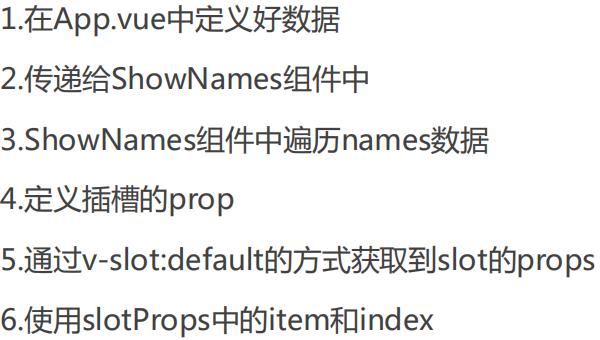vue3中Slot常见使用
Posted 嘴巴嘟嘟
tags:
篇首语:本文由小常识网(cha138.com)小编为大家整理,主要介绍了vue3中Slot常见使用相关的知识,希望对你有一定的参考价值。
下面先来认识一下插槽
在开发中,我们会经常封装一个个可复用的组件:
- 前面我们会通过props传递给组件一些数据,让组件来进行展示;
- 但是为了让这个组件具备更强的通用性,我们不能将组件中的内容限制为固定的div、span等等这些元素;
- 我们应该让使用者可以决定某一块区域到底存放什么内容和元素;
如何使用插槽slot?
- 插槽的使用过程其实是
抽取共性、预留不同; - 我们会将共同的元素、内容依然在组件内进行封装;
- 同时会将不同的元素使用slot作为占位,让外部决定到底显示什么样的元素;
- 在封装组件中,使用特殊的元素就可以为封装组件开启一个插槽;
- 该插槽插入什么内容取决于父组件如何使用;
插槽的基本使用

App.vue
<template>
<div>
<my-slot-cpn>
<button>我是按钮</button>
</my-slot-cpn>
<my-slot-cpn>
<my-input-cpn />
</my-slot-cpn>
<h2>我不是插槽的组件</h2>
<my-slot-cpn>
<h4>插槽里面很多内容</h4>
<i>你信不信我</i>
<del>啦啦啦啦啦</del>
</my-slot-cpn>
<my-slot-cpn></my-slot-cpn>
</div>
</template>
<script>
import MySlotCpn from "./MySlotCpn.vue";
import MyInputCpn from "./MyInputCpn.vue";
export default {
name: "App",
components: { MySlotCpn, MyInputCpn },
methods: {},
};
</script>
<style scoped>
</style>
MySlotCpn.vue
<template>
<div>
<h3>组件的开始</h3>
<slot>
<i>我是插槽,没有填写信息,我就是默认的</i>
</slot>
<h3>组件的结束</h3>
</div>
</template>
<script>
export default {};
</script>
<style lang="scss" scoped>
</style>
MyInputCpn.vue
<template>
<div>
<input type="text" placeholder="我是输入框" />
</div>
</template>
<script>
export default {};
</script>
<style lang="scss" scoped>
</style>
具名插槽的使用-动态插槽名
- 具名插槽顾名思义就是给插槽起一个名字, 元素有一个特殊的 attribute:name;
- 一个不带 name 的slot,会带有隐含的名字 default;
我们可以通过 v-slot:[dynamicSlotName]方式动态绑定一个名称;
具名插槽使用的时候缩写:
跟 v-on 和 v-bind 一样,v-slot 也有缩写;
即把参数之前的所有内容 (v-slot:) 替换为字符 #;
<template>
<div>
<nar-bar :name="name">
<template v-slot:left> 我是左边的插槽 </template>
<template v-slot:center>我是中间的插槽</template>
<template v-slot:right>我是右边的插槽</template>
<template #[name]>我是语法糖和动态插槽</template>
</nar-bar>
</div>
</template>
<script>
import NarBar from "./NarBar.vue";
export default {
name: "App",
data() {
return {
name: "lisi",
};
},
components: {
NarBar,
},
};
</script>
<template>
<div>
<div class="nav-bar">
<div class="left"><slot name="left"></slot></div>
<div class="center"><slot name="center"></slot></div>
<div class="right"><slot name="right"></slot></div>
<div class="name"><slot :name="name"></slot></div>
</div>
</div>
</template>
<script>
export default {
props: {
name: String,
},
};
</script>
渲染作用域
在Vue中有渲染作用域的概念:
- 父级模板里的所有内容都是在父级作用域中编译的;
- 子模板里的所有内容都是在子作用域中编译的;
案列

认识作用域插槽
但是有时候我们希望插槽可以访问到子组件中的内容是非常重要的:
- 当一个组件被用来渲染一个数组元素时,我们使用插槽,并且希望插槽中没有显示每项的内容;
- 这个Vue给我们提供了作用域插槽;
使用步骤

ShowNames.vue
<template>
<div>
<template v-for="(item, index) in names" :key="item">
<slot :item="item" :index="index"></slot>
<slot name="lisi"></slot>
</template>
</div>
</template>
<script>
export default {
props: {
names: {
type: Array,
default: () => []
}
}
}
</script>
<style scoped>
</style>
App.vue
<template>
<div>
<nar-bar :name="name">
<template v-slot:left> 我是左边的插槽 </template>
<template v-slot:center>我是中间的插槽</template>
<template v-slot:right>我是右边的插槽</template>
<template #[name]>我是语法糖和动态插槽</template>
</nar-bar>
<hr />
<show-names :names="names">
<template v-slot="names">
<p>{{ names.item }}-{{ names.index }}</p>
</template>
</show-names>
<hr />
// 如果我们有默认插槽和具名插槽,那么按照完整的template来编写
<show-names :names="names">
<template v-slot="slotProps">
<span>{{ slotProps.item }}---{{ slotProps.index }}</span>
</template>
</show-names>
<hr />
// 果我们的插槽只有默认插槽时,组件的标签可以被当做插槽的模板来使用,这样,我们就可以将 v-slot 直 接用在组件上
<show-names :names="names" v-slot="slotProps">
<button>{{ slotProps.item }}-{{ slotProps.index }}</button>
</show-names>
<hr />
<show-names :names="names">
<template v-slot="slotProps">
<button>{{ slotProps.item }}-{{ slotProps.index }}</button>
</template>
//如果我们的插槽是默认插槽default,那么在使用的时候 v-slot:default="slotProps"可以简写为vslot="slotProps":
<template v-slot:lisi>
<h2>我是name的插入内容</h2>
</template>
</show-names>
</div>
</template>
<script>
import NarBar from "./NarBar.vue";
import ShowNames from "./ShowNames.vue";
export default {
name: "App",
data() {
return {
names: ["张三", "李四", "王五", "赵六", "孙七"],
};
},
components: {
NarBar,
ShowNames,
},
};
</script>
以上是关于vue3中Slot常见使用的主要内容,如果未能解决你的问题,请参考以下文章